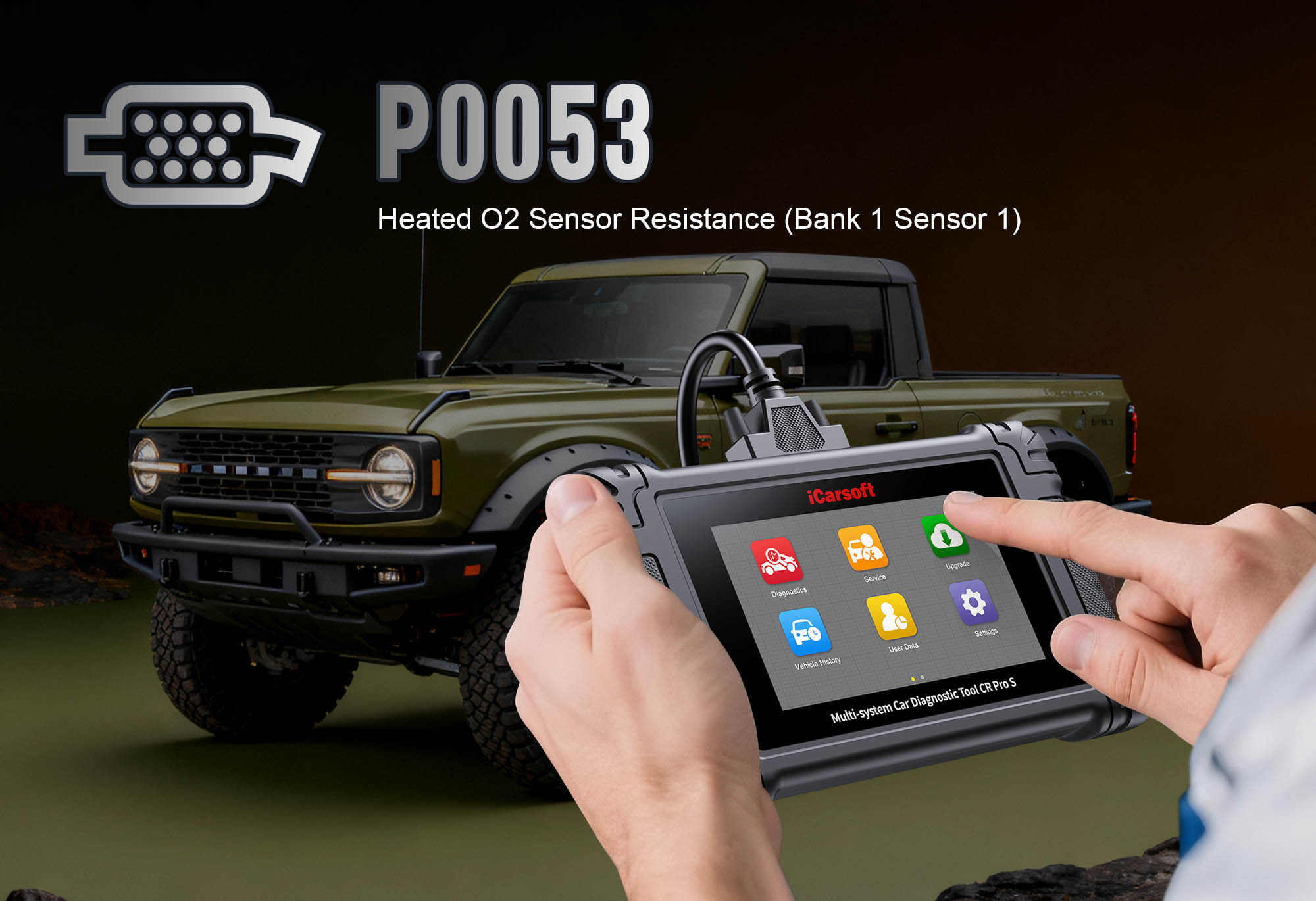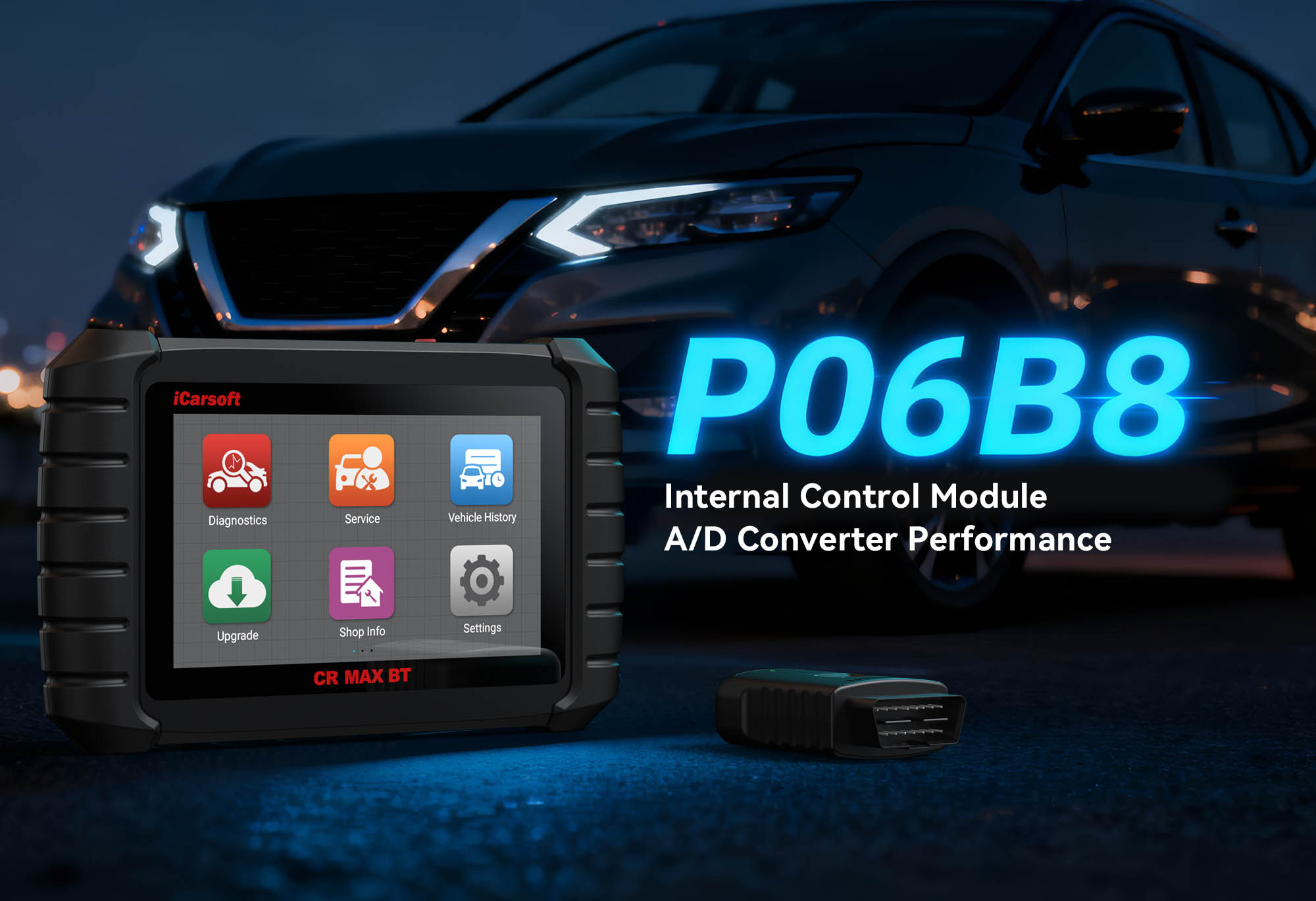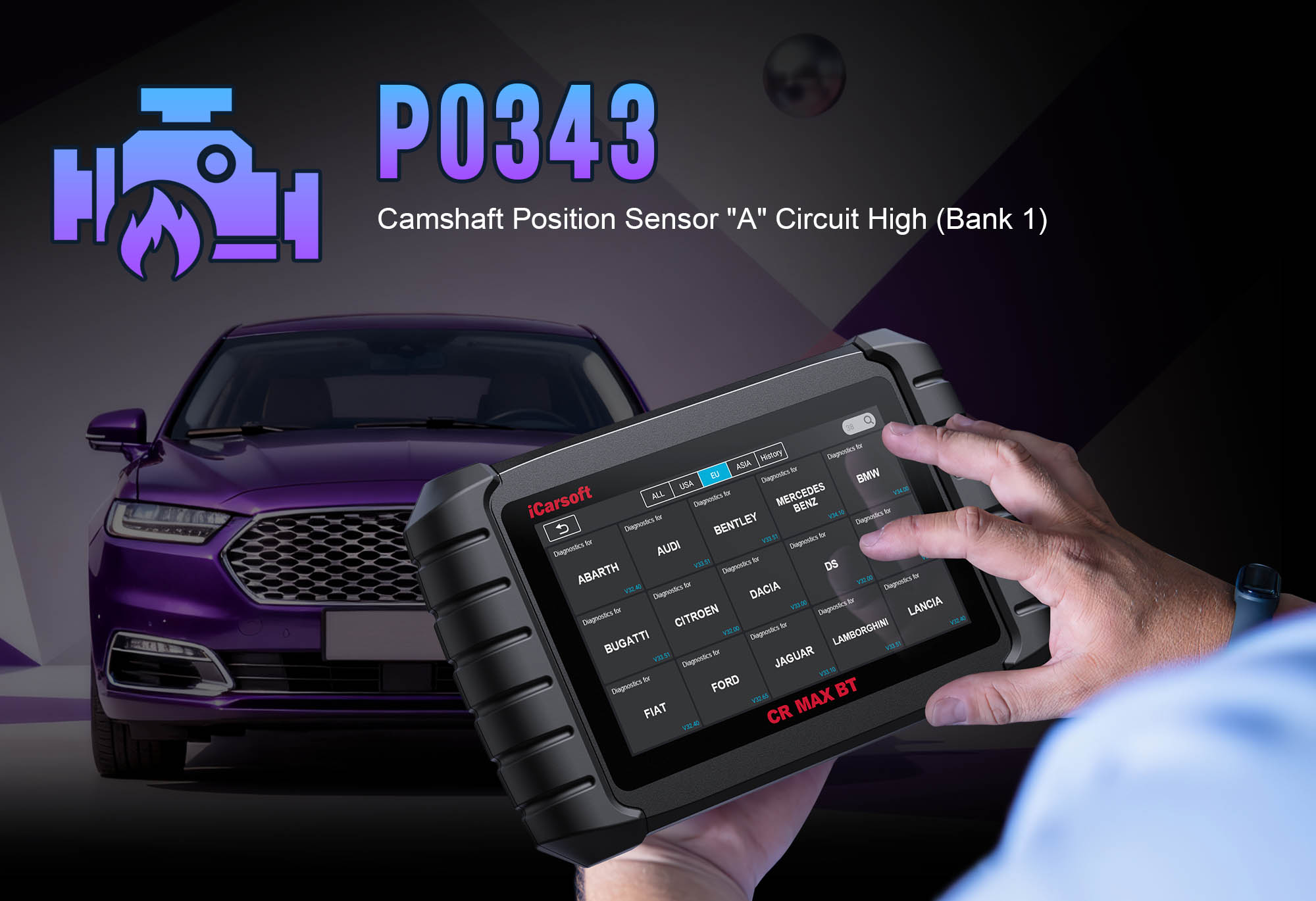P0053 Code: Diagnose & Clear O2 Sensor Heater Control Circuit High Resistance with iCarsoft CR Pro S
If your check engine light turns on and you notice symptoms like slow sensor warm-up, poor fuel economy, or failed emissions tests, a diagnostic scan will likely return P0053. This OBD-II code stands for "Oxygen (O2) Sensor Heater Control Circuit High Resistance," indicating the Engine Control Module (ECM) detected abnormally high electrical resistance in the heater circuit of the upstream (pre-catalytic converter) O2 sensor—typically Bank 1, Sensor 2 (or Bank 2, Sensor 1 in V-engines).
O2 sensors need an internal heater to reach 600–800°F quickly for accurate oxygen readings, which the ECM uses to adjust the air-fuel mixture. The heater circuit (sensor element, wiring, ECM components) requires low resistance (1–10 ohms) to function. Exceeding 15 ohms (ECM’s threshold) stops the heater from drawing enough current, causing delayed/inaccurate readings. Left unaddressed, P0053 leads to fuel waste, catalytic converter damage, and emissions failures.
Basic scanners only flag "O2 sensor fault" but can’t measure resistance or separate wiring issues from sensor failure. The iCarsoft CR Pro S, with resistance testing, live monitoring, and circuit diagnostics, solves this. Let’s walk through precise diagnosis and resolution.
Understanding P0053: Causes & Key Symptoms
High resistance in the heater circuit disrupts sensor performance, with symptoms tied to delayed warm-up and bad data—these clues help isolate wiring issues from sensor failure.
Key Symptoms of P0053
-
Slow Warm-Up Warning: Check engine light illuminates 5–10 minutes after startup (ECM waits to detect heater issues).
-
Poor Fuel Efficiency: Delayed O2 readings make the ECM misadjust the air-fuel mixture—fuel economy drops 10–20%.
-
Rough Idling: Engine shakes at 500–1,000 RPM as the ECM lacks reliable sensor data for fuel balance.
-
Failed Emissions Tests: Unregulated mixtures raise hydrocarbon (HC) and carbon monoxide (CO) levels.
-
Catalytic Converter Overheating: Rich fuel mixtures send unburned fuel to the converter, risking damage.
-
Intermittent Issues: Symptoms come and go—triggered by vibration (loose connectors) or temperature (wiring shrinkage).
Common Causes of P0053
Rust or oxidation on the sensor’s electrical connector creates high resistance in the circuit.
|
Cause
|
Description
|
|
Faulty O2 Sensor Heater Element
|
Internal corrosion or burnout (common in sensors >80,000 miles) increases resistance beyond 15 ohms.
|
|
Corroded/Loose Connectors
|
|
Frayed/Damaged Wiring
|
Worn insulation or broken strands (near hot exhaust) raise resistance in the heater circuit.
|
|
Poor Ground Connection
|
Loose/corroded ground strap for the sensor circuit increases overall resistance.
|
|
ECM Heater Driver Malfunction
|
The ECM’s internal current regulator fails, misinterpreting normal resistance as high.
|
|
Water Intrusion
|
Moisture in the sensor connector (leaks/off-road use) corrodes pins and disrupts electrical flow.
|
Why iCarsoft CR Pro S Excels at Diagnosing P0053
The CR Pro S outperforms basic tools with high-resistance-focused features, critical for isolating P0053’s root cause:
Heater Circuit Resistance Testing
Directly measures resistance in the sensor heater and wiring, flagging values above the 1–10 ohm normal range.
Live Circuit Monitoring
Tracks real-time current draw and voltage—shows how high resistance reduces heater performance.
Wiring/Connector Diagnostics
Includes continuity tests to spot frayed wires or corroded connectors that raise resistance.
Sensor Temperature Tracking
Verifies if high resistance prevents the sensor from reaching 600–800°F (operating temp).
Global Bank/Sensor Coverage
Adapts to 500+ models (Ford, Toyota, BMW, Mercedes-Benz) for O2 sensor bank/sensor numbering variations.
ECM Heater Control Tests
Checks if the ECM sends correct current to the heater circuit—rules out internal module faults.
Step-by-Step: Diagnose P0053 with iCarsoft CR Pro S
-
Locate the Affected O2 Sensor
1. Navigate to Component Location > Engine > Emissions > Oxygen Sensors.
2. Identify the target sensor:
- Bank 1: Cylinder 1 side; Bank 2: Opposite side (V-engines).
- Sensor 2: Downstream from Sensor 1 (still pre-catalytic converter).
3. Note the heater circuit wires (red/black or white/black) connecting the sensor to the ECM/battery.
-
Connect the CR Pro S & Confirm the Code
1. Plug into the OBD-II port (use OBDI adaptors for older models: Mercedes 38Pin, BMW 20Pin).
2. Select your vehicle via Auto VIN Identify (instant specs) or manual entry.
3. Navigate to Engine > Fault Codes > Read Codes to confirm P0053. Tap Code Details for tips (e.g., "Ford F-150 5.0L: Target Heater Resistance = 1–5 Ohms").
-
Inspect for Obvious Circuit Issues
1. Connector Inspection: Disconnect the sensor connector—check for corrosion (green/white powder), bent pins, or moisture (dry with compressed air).
2. Wiring Check: Follow heater wires to the ECM—look for frayed insulation, melting (near exhaust), or loose connections.
3. Ground Strap: Locate the sensor’s ground strap (chassis/engine block)—clean rust with a wire brush and tighten if loose.
-
Analyze Live Heater Circuit Data
1. Start the engine, idle 5 minutes (ECM activates the heater).
2. Navigate to Engine > Live Data > Emissions > O2 Sensor (Bank 1, Sensor 2) and monitor:
- Heater Resistance: Normal = 1–10 ohms. P0053 = >15 ohms.
- Heater Current Draw: Normal = 0.5–1.5A. <0.3A = high resistance.
- Sensor Temperature: Normal = 600–800°F. <500°F = resistance preventing warm-up.
- Heater Voltage: Normal = 12–14V. Consistent voltage + low current = high resistance (Ohm’s Law: V=I×R).
-
Test the O2 Sensor Heater Element Resistance
1. Turn off the engine, disconnect the sensor connector.
2. Use Multimeter Function to measure resistance between the two heater pins (labeled "HEATER+"/"HEATER-").
3. Compare to specs:
- Normal = 1–10 ohms.
- >15 ohms = heater element failure (replace sensor).
- Infinite resistance = open circuit (heater burnout—replace sensor).
-
Test Wiring & Connector Continuity
1. Wiring Continuity: Disconnect the ECM connector. Measure resistance between sensor heater pin and ECM pin (use wiring diagram). Normal = <5 ohms. >10 ohms = high resistance (repair harness).
2. Connector Resistance: Reconnect the sensor (disconnect ECM). Measure resistance across connector heater pins. Higher than sensor resistance = corroded connector (clean/replace).
3. Ground Test: Measure resistance between sensor ground pin and chassis. Normal = <1 ohm. >5 ohms = poor ground (replace strap).
-
Perform Bi-Directional Heater Activation Test
1. Navigate to Special Functions > Engine > Emissions > O2 Sensor Heater Test.
2. Select Activate Heater—CR Pro S commands the ECM to supply full power.
3. Monitor:
- Current rises to 0.5–1.5A = wiring/connectors good. No rise = sensor/wiring fault.
- Temperature rises 100–200°F in 2 minutes = heater works. No rise = irreparable resistance.
-
Rule Out ECM Issues
1. ECM Heater Driver Test: Go to Special Functions > Engine > ECM > Heater Driver Test. Failed test = ECM internal fault (consult pro).
2. ECM Firmware Update: Install free updates via Update Manager—fixes misinterpreted resistance readings.
-
Repair & Clear P0053
1. Fix the root cause:
- Faulty Sensor: Replace with OEM unit (use Part Lookup for Bank 1, Sensor 2 compatibility).
- Wiring/Connector: Repair frayed wires, clean corroded connectors, or replace harness.
- Poor Ground: Tighten/replace the ground strap.
- ECM Fault: Update firmware or have the ECM repaired.
2. Clear the code: Navigate to Engine > Fault Codes > Clear Codes to delete P0053.
-
Validate the Repair
1. Recheck live data: Resistance = 1–10 ohms; current = 0.5–1.5A; temperature = 600–800°F.
2. Test drive 30–40 minutes (stop-and-go + highway): No rough idle or poor fuel efficiency.
3. Post-drive scan: Use Emissions System Scan after 50 miles to confirm P0053 doesn’t return.
4. (Optional) Run Emissions Check to verify compliance.
Preventing P0053 Recurrence
Use the iCarsoft CR Pro S to maintain heater circuit health long-term:
-
Sensor Maintenance: Set Service Reminder to replace upstream O2 sensors every 60,000–100,000 miles (sooner in harsh conditions).
-
Resistance Checks: Include heater circuit resistance tests in annual electrical scans—catch corrosion early.
-
Connector Care: Apply dielectric grease to sensor connectors after cleaning to prevent moisture and corrosion.
-
Ground Strap Inspection: Check ground connections every 30,000 miles—clean and tighten to avoid high resistance.
Conclusion
P0053’s high resistance in the O2 sensor heater circuit undermines efficiency and emissions compliance—but the iCarsoft CR Pro S simplifies diagnosis with resistance testing, live monitoring, and circuit checks. Whether replacing a faulty sensor, fixing wiring, or addressing a poor ground, this tool ensures you fix the root cause (not just the symptom).
With the CR Pro S, you’ll restore fast sensor warm-up, improve fuel economy, and pass emissions tests—no more costly catalytic converter damage or unnecessary part replacements.
FAQs About P0053 Code
Q: Can I drive with P0053?
A: Short trips (to a repair shop) are safe, but prolonged driving increases fuel waste and catalytic converter risk. Fix P0053 within 1–2 weeks.
Q: How much does it cost to fix P0053?
A: $80–$300 for an OEM O2 sensor; $50–$200 for wiring/connector repairs; $400–$1,200 for ECM repairs. The CR Pro S saves by avoiding unnecessary ECM replacement.
Q: Will cleaning the O2 sensor fix P0053?
A: No—P0053 is a heater circuit resistance issue, not sensor contamination. Cleaning won’t fix a burnt heater element or corroded wiring.
Q: What’s the difference between P0053 and P0052?
A: P0053 = "Heater Circuit High Resistance" (Bank 1, Sensor 2), while P0052 = "Heater Circuit High Voltage" (same sensor). The CR Pro S distinguishes them via resistance vs. voltage tests.





